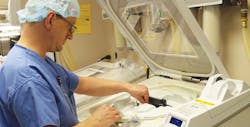Reusable endoscopes: Tried and true for cleaning
Disposable or single-use-only endoscopes may be the buzzword poking at the sterile processing zeitgeist right now, but reusable models remain the overwhelming preference among clinicians and sterile processing professionals.
Call it a case of status quo or sacred cows, but Surgical Services and Sterile Processing professionals both need more supportive evidence before they agree to take the plunge into the pre-packaged world, eschewing to an extent, what one SPD expert calls the “gold standard” of endoscopy.
Reusable models elicit their own pros and cons, experts insist. Here’s a breakdown of both sides.
Overt, covert pros
Dan Gusanders, President, Pure Processing
“Reusable endoscopes are the gold standard of care for performing endoscopic procedures. They are reliable and offer high-quality care to our patients. Endoscopes are widely available and are FDA-cleared to perform procedures per the intended use of the device. They provide high-quality images, video, therapeutic options, handling and validated IFUs and reprocessing instructions.
“Costs may be contained by continuing to utilize reusable endoscopes. Assuming that capital equipment is already purchased, then the cost is realized in the maintenance of those items. Again, this is dependent on the particular facility’s circumstances, but reusable endoscopes can keep disposal of single-use items to a minimum. Additionally, facility staff, such as the physicians, are familiar with the performance, operation and handling of their endoscopes and reprocessing staff should be familiar with the instructions on how to properly clean and disinfect or sterilize them.”
Mary Ann Drosnock, FAPIC, CIC, CFER, RM (NRCM), Senior Manager of Clinical Education, Healthmark Industries
- “Expected endoscope quality and function: The current quality of image, function, and related system technologies are the industry standard and true equality in a disposable form is unlikely.
- “Reusable equipment cost may prove to show financial savings: Depending on the individual facility, reusable equipment handled and reprocessed properly, there may be cost savings captured over disposable devices.
- “Physician case times and expected patient outcomes are established: Current endoscopes provide a “known” feel and function that allow physicians to expediently complete their cases in an effective manner with positive patient outcomes.
- “Patient cases could be impacted in unexpected ways: Significant altering of the feel and anticipated function of the endoscope could result in longer cases requiring additional sedation and increase patient discomfort.
- “Disposable endoscopes are an emerging technology being produced by new companies without past experience for the manufacturing development of the current reusable versions’ nuances: While final product design may be very different, the samples of disposable endoscope models I have held in my hands were too rigid. Additionally, the placement of key functions such as air/water on a keypad or an extraneous location to the control body will most likely cause great frustration and lack of efficiency.”
Melissa Kubach, Educator/Quality Manager, Unitas Medical Services Inc., a Mobile Instrument Service & Repair Company
“Advanced functionality: Reusable devices are able to integrate advanced technology not economically feasible in single-use devices.
Pika Lynch, R.N., Director, Clinical Services, TSO3 Corp.
spacer
“Reusable endoscopes enjoy a long successful track record. Overall, when [they are] fully clean and high-level disinfected or sterilized, reusable endoscopes are safe for patients. Reusable endoscopes, when maintained and used correctly, average hundreds of cycles. Their cost usage basis with diligent leak testing, care and handling, and a good service provider should be significantly less than price points currently associated with disposable endoscopes.
“Physicians are familiar with each endoscope manufacturer’s performance and rely on it each day. Overall, present-day reusable endoscopes deliver high-quality performance over upcoming disposable endoscopes.”
Minerva Lorán, President, Clinical Choice LLC
- “Proven technology
- “Surgeons comfortable using
- “Reduces disposables
- “More patterns, types available.”
Rick Schultz, President, RMPS Publishing LLC, and former CEO, Spectrum Surgical Instruments, part of STERIS IMS
Overt, covert cons
Healthmark’s Drosnock: “If not reprocessed properly and if applicable standards and professional society guidelines are not followed, endoscopes carry a risk of device-associated infections. Endoscopes are expensive to purchase and to maintain and can be difficult to clean and disinfect. Instructions for use (IFUs) and for reprocessing can be challenging to follow and implement.
“Use of damaged or dirty endoscope on patients carries significant risk. Therefore, facilities must perform enhanced visual inspection on endoscopes and cleaning verification tests after manual cleaning to confirm that they have been adequately processed and are not in need of repair. There have been reports of reuse of damaged equipment leading to exposure of patients to infection risks. Inspection and verification of cleaning are an integral step in the process. Since use of reusable endoscopes does necessitate that cleaning chemistries and disinfectants be used routinely, there is more exposure of staff to harsh chemicals. Disposal of those chemicals along with single-use endoscopic accessories also contribute to waste streams. Water consumption is directly increased by the required rinsing steps of processing endoscopes, namely rinsing after cleaning and rinsing after disinfection.”
Pure Processing’s Gusanders:
- “The risk of cross-contamination is present each time the scope is reprocessed, unless all IFU are followed to the letter.
- “Manual cleaning can be cumbersome and carries the potential of repetitive motion and other ergonomic injuries.
- “Pain from workplace injuries can make the job harder to complete as instructed.
- “Single-use endoscope models may be more standardized and less frequently updated with the newest features and therapeutic benefits.
- “Despite the availability of ergonomic and automated cleaning solutions that make the process more comfortable and faster, some facilities persist in continuing labor-intensive and time-consuming manual methods such as syringe flushing by hand.”
Unitas’ Kubach:
- “Expected endoscope quality and function: The current quality of image, function, and related system technologies are the industry standard and true equality in a disposable form is unlikely.
- “Reusable equipment cost may prove to show financial savings: Depending on the individual facility, reusable equipment handled and reprocessed properly, there may be cost savings captured over disposable devices.
- “Physician case times and expected patient outcomes are established: Current endoscopes provide a ‘known’ feel and function that allow physicians to expediently complete their cases in an effective manner with positive patient outcomes.
“Equipment tracking for location and recall purposes would be eliminated: Recall tracking would be reduced to scanning a product sticker.”
TSO3’s Lynch:
- “Cross-contamination: Failure to effectively reprocessing endoscopes are listed as second on the ‘Top 10 Health Technology Hazards for 2018,’ published by the ECRI Institute, and has been in the top 10 list for several years. Infections caused by cross-contamination from inadequately reprocessed endoscopes have recently been reported in many states, and several patients died from infections like CRE.
- “Wear and tear: Reusable endoscopes should be carefully inspected for wear and tear before patient use.
- “Ineffectiveness of HLD and EtO: Recent independent scientific publications have shown that high-level disinfection and ethylene oxide sterilization are not sufficient to remove contaminants from endoscopes that can cause cross contamination.
- “Cleaning: Manual cleaning and proper drying are critical to successful reprocessing of reusable endoscopes. This requires continual training and strict adherence to SOPs.
- “Recalls: This could conceivably wipe out a facility’s inventory and leave them unable to do procedures.
- “Reusing single use items: Some facilities will process and reuse single-use devices on multiple patients. This could present a significant risk to patient safety.
- “Scopes not being dry: If a facility is not regimented on the drying process with a scope, you could have an exposure to the patient with retained hydrogen peroxide in the scope. Scopes are also introduced into delicate mucal membrane areas that would be damaging and difficult to treat.”
RMPS Publishing’s Schultz:
- “Chance of cross contamination
- “Repair costs
- “Initial investment is high
- “Cost to reprocess
- “Managing loaners.”
SCOPES:
Single-use endoscopes: Pop fly or home run in cleaning, sterilization?
Tips, tools and tricks for inspecting properly cleaned endoscopes
If you’re being scoped, shouldn’t that scope be tested first?
About the Author
Rick Dana Barlow
Senior Editor
Rick Dana Barlow is Senior Editor for Healthcare Purchasing News, an Endeavor Business Media publication. He can be reached at [email protected].





